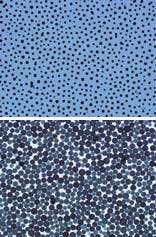Gel mimics color change of cephalopods
Incorporating news from O plus E magazine, Tokyo
TOKYOThe Intelligent Devices Lab of Fuji Xerox, led by group leader Ryojiro Akashi, has developed a novel light modulation material modeled after the pigment cells of cephalopods such as squid and octopi. Cephalopods, which can change color instantly, have pigment cells with micromachine-like functions. A pigment cell consists of a flexible pigment bag with multiple muscle fibers bonded to the bag. When the muscle fibers stretch and the pigment bag expands by several to several dozen times in size, the color changes.
The research group has developed a synthetic version of these pigment cells by using polymer gels with high concentration pigments. These synthetic cells change reversibly when external stimuli such as heat, electricity, and light are applied. Polymer gels are known to have properties such as very high water absorbance and stimulus-induced volume transitions. Reversible color change can be accomplished by distributing and fixing high-concentration pigments in a polymer gel network and then expanding and contracting the gel (see figure). The pigments are easily obtained. These light-modulation materials have a very simple structure, so they are chemically stable; time-accelerated experiments have confirmed that they are colorfast up to 30 years. The optical properties are also superior, with more than 80% transmission in the contracted state (for a gel that has a maximum volume-changing capacity of around 10 times).
The group has injected and sealed the polymer gel between sheets of glass to create light-modulating windows that change color depending on the temperature, with the glass being opaque and blue at room temperature and transparent and clear at 40°C. This window is currently in the testing stage, but the goal is to commercialize the product by the year 2003. Potential uses go beyond light-modulating glass to include display components, sensors, and electronic inks.
Courtesy O plus E magazine, Tokyo

